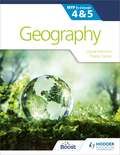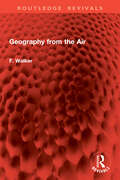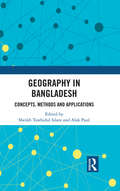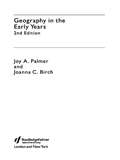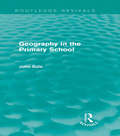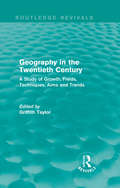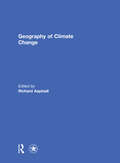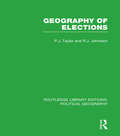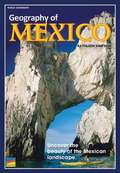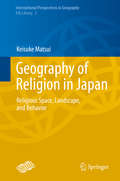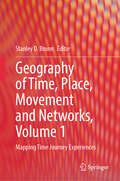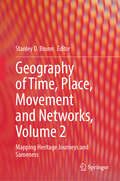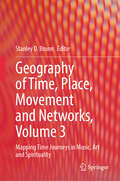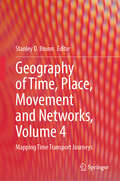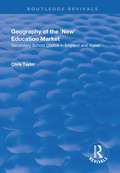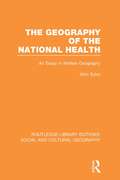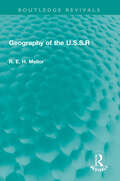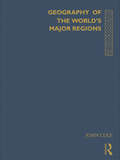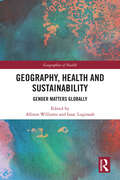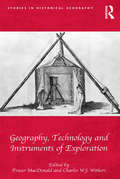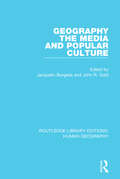- Table View
- List View
Geography for the IB MYP 4&5: by Concept
by Louise Harrison Thierry TorresDevelop your skills to become an inquiring learner; ensure you navigate the MYP framework with confidence using a concept-driven and assessment-focused approach to Geography, presented in global contexts.- Develop conceptual understanding with key MYP concepts and related concepts at the heart of each chapter. - Learn by asking questions for a statement of inquiry in each chapter. - Prepare for every aspect of assessment using support and tasks designed by experienced educators.- Understand how to extend your learning through research projects and interdisciplinary opportunities.- Think internationally with chapters and concepts set in global contexts.
Geography from the Air (Routledge Revivals)
by F. WalkerFirst Published in 1953, Geography from the Air is the first book in English to explain and illustrate fully the use of air photographs in the study of geography. It sets out in simple form the limited amount of technical information which is necessary in order to enjoy fully the fascinating experience of training oneself to appreciate almost every aspect of the landscape shown on vertical air photographs. Thereafter the book consists of nearly 100 high quality air photographs, selected from almost every part of Britain, each of which is accompanied by a text describing in detail the features of general, as well as of geographical, interest which can be detected on the photographic prints.The photographs have been grouped into sections detailing with many aspects of physical and human geography, such as the influence of geology on landforms, river erosion and river development, glacial action, coast forms, the relationships between relief and settlement, the appearance of varying agricultural and industrial regions and the shape and character of towns and villages etc. Apart from the explanation of this new geographical technique the selection of photographs is such that this book should serve as a valuable source of illustrative material for the study of the geography of Britain and the systematic treatment of physical and human geography.
Geography in Bangladesh: Concepts, Methods and Applications (Global Perspectives On Health Geography Ser.)
by Sheikh Tawhidul Islam Alak PaulThis book provides an overview of the emergence of geography as a discipline in Bangladesh and the contributions made by local geographers towards the development of the country. It explores problems associated with population growth and poverty, landlessness and food security, land use and natural resource management, urbanism, climate change, disaster management and human health. The volume shows how research and the study of geography in the ‘periphery’ can contribute in achieving progress in countries like Bangladesh and help them prepare against imminent disasters, ecological, social, economic shocks and uncertainties. This book will be useful to students and researchers of geography, environment studies, disaster management, development studies, geoinformatics, geology, demography, sociology and South Asian studies with a particular focus on Bangladesh. It will also interest various policy makers and NGO professionals working in these and related fields.
Geography in Britain after World War II: Nature, Climate, and the Etchings of Time
by Vinita Damodaran Max Martin Rohan D’SouzaContemporary anxieties about climate change have fueled a growing interest in how landscapes are formed and transformed across spans of time, from decades to millennia. While the discipline of geography has had much to say about how such environmental transformations occur, few studies have focused on the lives of geographers themselves, their ideologies, and how they understand their field. This edited collection illuminates the social and biographical contexts of geographers in postwar Britain who were influenced by and studied under the pioneering geomorphologist, A. T. Grove. These contributors uncover the relationships and networks that shaped their research on diverse terrains from Africa to the Mediterranean, highlighting their shared concerns which have profound implications not only for the study of geography and geomorphology, but also for questions of environmental history, ecological conservation, and human security.
Geography in Classical Antiquity
by Daniela Dueck a chapter by Kai BrodersenWhat were the limits of knowledge of the physical world in Greek and Roman antiquity? How far did travellers get and what did they know about far-away regions? How did they describe foreign countries and peoples? How did they measure the earth, and distances and heights on it? Ideas about the physical and cultural world are a key aspect of ancient history, but until now there has been no up-to-date modern overview of the subject. This book explores the beginnings and development of geographical ideas in Classical antiquity and demonstrates technical methods for describing landscape, topographies and ethnographies. The survey relies on a variety of sources: philosophical and scientific texts but also poems and travelogues; papyrological remains and visual monuments.
Geography in the Early Years
by Joanna Birch Joy PalmerThis completely revised and updated second edition of Geography in the Early Years presents a lively and comprehensive overview of teaching and learning in geography. Theoretical aspects of early years teaching in geography are complemented by up-to-date research findings and illustrated with discussion, a wealth of case studies, and suggestions for the development and implementation of sound geographical work in practice. In a practitioner-friendly style, this book provides: an examination of the essence of geography in terms of children's conceptions of the physical environment a detailed description of geography in the national curriculum and of the place and nature of environmental education within early years teaching guidelines for taking a whole school approach in policy, planning and organisation of geographical learning examples of initial teacher training and continuing professional developments. This highly accessible, illuminating book will be immensely helpful to teachers, student teachers, policy-makers and all other providers of education for children aged three to seven years.
Geography in the Primary School (Routledge Revivals)
by John BaleFirst published in 1987, this title provides primary school teachers with ideas by which geographical skills and ideas can be introduced in the primary school. John Bale shows how teachers can build on children’s ‘private geographies’ with practical learning strategies, examining approaches to the teaching of map skills, the ways in which the locality can be used and how information about distant places can best be relayed. An interesting, useful and relevant guide, this title will be of particular value for teachers and teachers in training, as well as those studying primary Education more generally.
Geography in the Twentieth Century: A Study of Growth, Fields, Techniques, Aims and Trends (Routledge Revivals)
by Griffith TaylorThis title, first published in 1951, examines the growth, fields, techniques, aims and trends of geography at the time. The book is divided into three parts, of which the first deals with the evolution of geography and its philosophical basis. The second is concerned with studies of special environments and with advances in geomorphology, meteorology, climate, soils and regionalism. The last part describes field work, sociological and urban aspects, the function of the Geographical Society and geo-pacifics. Geography in the Twentieth Century will be of interest to students of both physical and human geography.
Geography of Climate Change
by Richard AspinallClimate change is one of the inescapable themes of current times. Climate change confronts society in issues as diverse as domestic and international political debate and negotiation, discussion in the media and public opinion, land management choices and decisions, and concerns about environmental, social and economic priorities now and for the future. Climate change also spans spatial, temporal and organisational scales, and has strong links with nature-society relationships, environmental dynamics, and vulnerability. Understanding the full range of possible consequences of climate change is essential for informed decision making and debate. This book provides a collection of chapters that span environmental, social and economic aspects of climate change. Together the chapters provide a diverse and contrasting series that highlights the need to analyze, review and debate climate change and its possible impacts and consequences from multiple perspectives. The book also is intended to promote discussion and debate of a more integrated, inclusive and open approach to climate change and demonstrates the value of geography in addressing climate change issues.This book was originally published as a special issue of Annals of the Association of American Geographers.
Geography of Elections: The 1983 General Election (Routledge Library Editions: Political Geography)
by Peter J. Taylor Ron JohnstonWithin an international framework, this work provides a fully comprehensive approach to the geographical coverage of elections. Numerous applications of ideas and concepts from human geography are incorporated into a new political context, illustrating the manner in which electoral patterns reflect and help produce the overall geography of a region or state. Discussions of various topics are well supported by numerous maps and diagrams which help clarify arguments and serve to define elections within their basic geographical context.
Geography of Mexico
by Kathleen Simpson Vicki RushworthFind out about warm beaches, high deserts, dense jungles, and active volcanoes as you journey through the six geographical regions of Mexico.
Geography of Religion in Japan
by Keisuke MatsuiThis book discusses modern aspects of Japanese religion in terms of cultural geography. To understand the function of religion, it is essential to examine it in the context of local societies. One of the distinguishing characteristics of Japanese religion is its diversity; indeed, it is often remarked that "Japan is a museum of religions. " In this work, the author clarifies some geographical aspects of the complex situation of Japanese religion. Chapter 1 discusses the trend of geographical studies of religion in Japan, of which four types can be identified. Chapter 2 focuses on certain characteristics of Japanese religious traditions by discussing tree worship and the landscape of sacred places. Chapter 3 clarifies regional divisions in the catchment areas of Japanese Shintoism by analyzing the distribution of certain types of believers. The author discusses two case studies: the Kasama Inari Shrine and the Kanamura Shrine. Chapter 4 discusses some modern aspects of sacred places and tourism through two case studies. The first part of the chapter focuses on changes in the types of businesses at the Omotesando of the Naritasan Shinshoji-Monzenmachi, and the following sections examine the revitalization of the local community through the promotion of religious tourism.
Geography of Time, Place, Movement and Networks, Volume 1: Mapping Time Journey Experiences
by Stanley D. BrunnThis book describes the journey concept relating to cultural and social history of Western and non-Western worlds. By including time journeys negotiated by women, racial minorities, artists, and scholars from the humanities and social, natural and physical scientists, the book explores time/space journeys in personal, professional, and cultural life and place experiences. The sixteen chapters in this book offer new insights into time/place worlds in different contexts including history, culture, astronomy, and science fiction. The concept is one where science and art worlds intersect in the emerging worlds of the unknown. With contributors from different disciplines and countries expanding our understanding of this concept, this volume provides a valuable source for disciplinary and interdisciplinary classes and seminars exploring these scholarly frontiers.
Geography of Time, Place, Movement and Networks, Volume 2: Mapping Heritage Journeys and Sameness
by Stanley D. BrunnThis book explores journeys in a time context with a focus on places, place meanings, and landscapes. Whether the journey relates to ancient or modern trails, roads, or railroads, or a historical or contemporary pilgrimage or a tourist venture in social contexts, the book addresses the importance of places and environmental settings, whereby time itself is described and defined in multiple contexts. The chapters discuss among others archaeological and pre-history settings, tourism settings, and heritage events, as well as regional and transnational migration routes and those used by historical nomadic cultures and postmodern nomads. Some time and place journeys are fluid and dynamic and re-interpreted while for others there is much “sameness” in the visible landscapes. Retaining the past and reconstructing the past are both journeys. That sameness concept is also applied to cultural and political worlds where there is little progress or reform to address social welfare and empowerment. This book opens the door for exploring shallow and deep journeys by those in the humanities and social sciences at local, national, and regional scales.
Geography of Time, Place, Movement and Networks, Volume 3: Mapping Time Journeys in Music, Art and Spirituality
by Stanley D. BrunnThis volume discusses the intersections of multiple human journeys and the importance of places and place settings, such as battlefield re-enactments, heritage fairs, pilgrimage sites and faith journeys. The chapters in this book describe among others racial history tourism, music festivals which are frequent time-journeys attracting local and regional audiences, as well as art journeys, displayed in museums, whereby place plays an important role in how journeys of the soul, culture, and state are intersected, displayed, and remembered. The book also provides insight into how the worlds of art, narratives, and images are evident in how youth draw and depict climate change, re-inventing the past for commercial tourism income and re-interpreting history for contemporary cultures. It shows how global warming is also a journey that is both intellectual and environmental and how politics is an important part of any constructed and reconstructed journey.
Geography of Time, Place, Movement and Networks, Volume 4: Mapping Time Transport Journeys
by Stanley D. BrunnThis book provides insight into the importance of place and place settings in personal journeys. It explores the worlds of time journeys in different contexts: daily work, community livelihoods, rural-urban migration, disease outbreaks and controls, cruise ship tours, and isolated frontier settings. Besides this, the book also addresses the networks connecting rural and urban places, transcontinental highways and railroads, rural-urban migration and other innovative journeys such as gas station road maps and body maps. The chapters also discuss how eradicating diseases are time/place journeys as is moving from a distant isolated frontier to a metropolis. As such, this book is a must read for those interested in exploring the intersections in and between the humanities and social/policy sciences.
Geography of Time, Place, Movement and Networks, Volume 5: Mapping Women and Family Journeys
by Stanley D. BrunnThis book investigates both early as well as recent accounts of journeys by women and families in African, Asian, East European, North and Latin American contexts. It discusses how places, place settings and transport routes, whether by land, sea, or air, were and remain important in the impacts these newcomers have on states and regions. The contributions to this book provide insight in laws and regulations related to women’s and refugees’ rights. They highlight the importance of place and location in defining rights and implementing reforms, such as the importance of the politics and the state in identifying rights in global contexts of refugee resettlement, cross-border employment, security and reshaping human institutions as well as the changing legal landscape related to for instance women participating in the Olympic Games and in national sports. The book also touches on the worlds of family landscapes, mapping family trees, family cemeteries and redefining immigrant city mixes. As such, the book offers readers to explore past, present, and future issues faced by women and families, regardless of place or country.
Geography of World Pilgrimages: Social, Cultural and Territorial Perspectives (Springer Geography)
by Lucrezia LopezThis book points out how pilgrimage studies rely on interdisciplinary academic interests, being always more determined by anthropological, social, cultural and economic factors. The volume gathers interdisciplinary contributions revealing different approaches and academic interests when researching pilgrimage. Finally, the proposal introduces a comparative international breath to reflect upon such complex phenomenon that since Antiquity still impregnates the history of human being across the world. As pilgrimage studies are closely related to mobility issues, how the contemporary mobile world is altering and re-signifying pilgrimage dynamics and meanings will also be discussed in detail. The term “pilgrimage” evokes key concepts deriving from different fields, all of them collected in the final glossary.The primary audience of this work are academics and researchers from different fields involved in pilgrimage studies. The work may also be useful in teaching (advanced) university courses.
Geography of the 'New' Education Market: Secondary School Choice in England and Wales (Routledge Revivals)
by Chris TaylorThis title was first published in 2000. A series of major reforms during the 1980s and 1990s have led to the transformation of the Education System in England and Wales. The new system is now based on market principles in schooling resources. Parents now have the opportunity to state a preference over the school they would like their children to attend. This fascinating book sets out the new geographies of education, focusing on the spatial organization of the new market system. Using Geographical Information Systems (GIS), it examines patterns of competition and choice based on pupil home postcodes and relates these to the decision-making process of parents. It also makes comparisons between different LEAs and schools in urban and rural areas, analyzing the constraints created by space and geography. In considering the effectiveness and impact of this new form of provision, the book plays an important role in understanding and appreciating the impact of the education market upon social mobility and community structure.
Geography of the National Health: An Essay in Welfare Geography (Routledge Library Editions: Social and Cultural Geography)
by John EylesThis book considers the social and geographical context in which the National Health Service (NHS) operated during the 1970s and 1980s. It argues that disease and health care systems are the product to a large degree of the wider social and cultural context. It explores the relationship between health, work, poverty, housing, class and culture. examines how resource allocation and social policies are determined by the wider social and cultural context. discusses how the health of the nation, broadly defined should best be managed. As relevant today as when it was originally published, comments on the nature of welfare geography, assesses the impact of integrated approaches on the policy process and points the way forward to geographies rather than a geography of the national health.
Geography of the U.S.S.R (Routledge Revivals)
by R. E. MellorOriginally published in 1964, and extensively illustrated with figures and charts, this volume gives an overview of both physical and human geography of the former USSR. The role that the geography of the country has played in shaping historical events and political forces is discussed, as is its role in the economy of the Soviet Union. The geography is examined by topics and regional differences explained within this framework. The book looks at some of the major problems posed by geographical conditions and how they have been tackled and as far as data allows, the success or failure of measures has been assessed.
Geography of the World's Major Regions
by John ColeThis volume presents a global view of today's most pressing issues through an analysis of the twelve major regions of the world. Environmental degradation, natural catastrophe, population pressures and human conflict all impact in different ways and to different degrees on the society and environment of these regions. Economic and political restructuring within each region is covered, and topics include: natural resources; agriculture; industry and services; the role of the military; and the impact of global economic change. This work is intended as an introduction for students studying the changing geography of the world, but should also provide a useful overview to students researching specific regions, seeking comparative analysis of regions, or following general courses on the economic and political geography of both the post-industrial and the developing worlds. Over 250 photographs, maps and figures complement a range of boxed case-studies, key points, questions and guides to further reading.
Geography, Health and Sustainability: Gender Matters Globally (Geographies of Health Series)
by Allison Williams Isaac LuginaahWith a global commitment to achieve gender equality by 2030, the SDGs present a historic opportunity to place gender as central to human progress across the globe. Gender equality, which requires the empowerment of all women and girls, is an explicit goal, in addition to being a fundamental prerequisite to and facilitator of most other SDGs. This edited collection provides a range of geographical and geospatial insights, from a variety of disciplinary and country-specific perspectives, to better understand gender and sustainable development. In addition to several African countries, Mexico, Japan, Canada, USA, and Cambodia are featured. A range of topical case studies examine women’s domestic and care work, including water collection, breastfeeding, food purchasing, and caring for elderly family members. Access to health care services is examined in the case of breast screening and antenatal care. Women’s engagement in the labour force is also addressed, with a specific look at the renewable energy sector; structural barriers to employment are discussed across a number of chapters, with clear strategies to break through these barriers. Finally, theoretical insights are proposed in better understanding and engaging in gendered inequalities in health.
Geography, Technology and Instruments of Exploration (Studies In Historical Geography Ser.)
by Fraser MacDonald Charles W.J. WithersFocusing on aspects of the functioning of technology, and by looking at instruments and at instrumental performance, this book addresses the epistemological questions arising from examining the technological bases to geographical exploration and knowledge claims. Questions of geography and exploration and technology are addressed in historical and contemporary context and in different geographical locations and intellectual cultures. The collection brings together scholars in the history of geographical exploration, historians of science, historians of technology and, importantly, experts with curatorial responsibilities for, and museological expertise in, major instrument collections. Ranging in their focus from studies of astronomical practice to seismography, meteorological instruments and rockets, from radar to the hand-held barometer, the chapters of this book examine the ways in which instruments and questions of technology - too often overlooked hitherto - offer insight into the connections between geography and exploration.
Geography, The Media and Popular Culture (Routledge Library Editions: Human Geography #3)
by Jacquelin Burgess John R GoldIn this book, originally published in 1985, British and North American geographers present original and challenging viewpoints on the media. The essays deal with a diverse content, ranging from the presentation of news to the nature of television programming and from rock music lyrics to film visions of the city.
